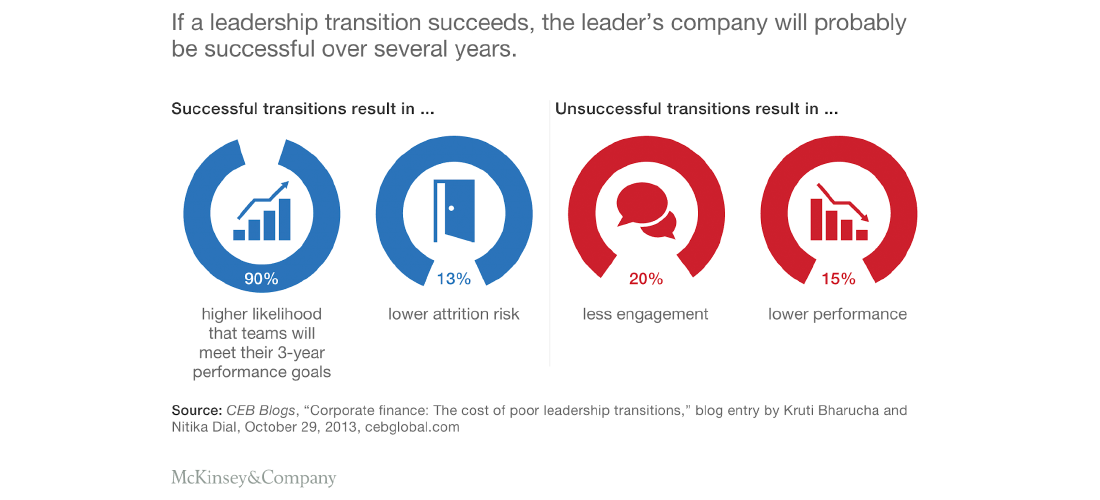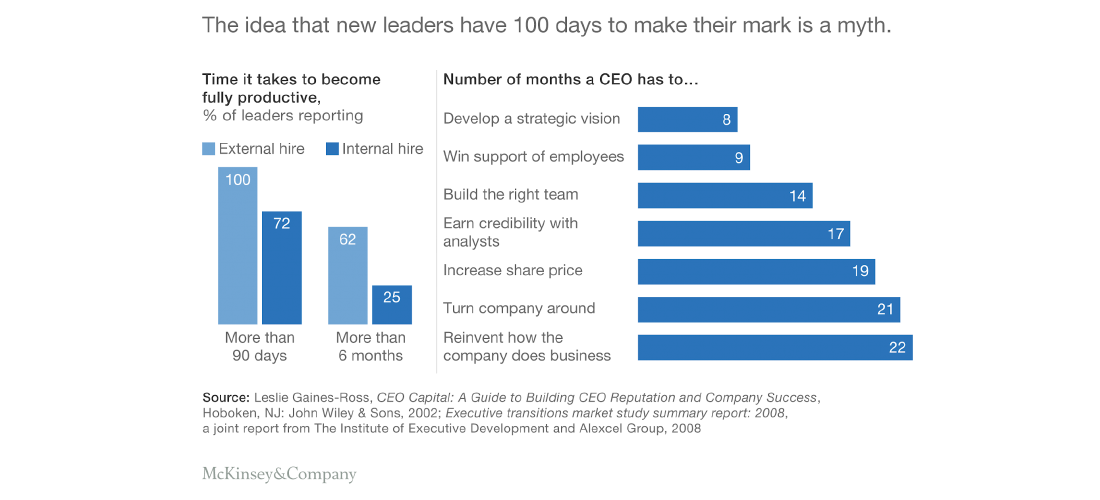
How To Get Leadership Transition Right
6 yearsago 2 Comments 2.3k Views
Being the Chief Executive Officer or CEO is one thing, but keeping the job is another. Today’s times have seen so many newly appointed CEOs fail too early on, with nearly half of them leaving the position within the first two years despite having sufficient knowledge, skills, and experience to lead the company.
Massive CEO Failure
Studies have shown that in the past two decades, 30% of Fortune 500 CEOs have lasted less than 3 years. According to the Harvard Business Review, nearly half of leadership transitions are regarded as failures or disappointments within the first 18 months on the job.
The role of the CEO has an immense impact on the entire organization, for better or for worse. If a leadership transition succeeds, the company will probably go on to meet its three-year performance goal and be successful for several years. On the other hand, if a leader struggles through transition, that would result in lower productivity and performance and much less engagement. Despite such high stakes, many CEOs are still underprepared for the transition into new roles.

What causes CEO failure?
There are many reasons leading to the massive failure of leadership transition. However, three reasons that stand out as key contributing factors are associated with (1) learning curve, (2) poor communication with staff and colleagues, and (3) micromanagement.
1. Learning curve
“What got you here won’t get you there.” – Marshall Goldsmith
CEOs often are senior leaders who demonstrated success and showed intelligence, initiative and results in their previous roles. As such, many of them assume they know what they are doing, and that they have sufficient skills and qualifications to manage whatever issues lie ahead when accepting the post. They would often rely on their instincts and initial impressions, believing what made them successful before will help them succeed again. However, this new position is much more challenging and different from anything they have encountered before. Once realized there is a lot of learning to do, some people even express their unwillingness to learn, adapt, and evolve – a toxic behavior no one, especially CEOs, should possess.
Learning also includes a deep knowledge of the business and functions, culture, team, stakeholders, as well as the leaders themselves. As such, failing to capture these five dimensions would make it extremely difficult to maintain and improve the organization, let alone driving business profits.
2. Poor communication with staff and colleagues
Good relationships begin with cultivating either formal or casual conversations with others. However, while many CEOs get the basics of communication right, their lack of an overarching communication strategy and weaknesses in how they engage with people are other contributing factors leading to increasing rates of CEO turnover. Leaders often assume that they have communicated enough and put their message across but in fact, they do not care about whether it has been received or not. For instance, some appear to be dishonest when giving feedback or ambiguous when communicating the plan, then let employees figure things out all by themselves. Altogether, this not only leads to a disengaged workplace but also harms morale and productivity, prevents CEOs from accessing important information, and affects their ability to accomplish tasks.
3. Micromanagement
CEO Coach Sabina Nawaz who interviewed 1,000 people on their CEOs’ behavior found that one of the most common mistakes new CEOs often make is micromanagement. They are too fixated on minor details, mistakes, and weaknesses, and would have a hard time letting go of certain things. As such, this leads some employees to think they are incapable or not reliable enough to make decisions themselves, causing psychological burdens such as stress and resentment. As time goes on, people might even stop trying and progressing, which weakens the vital team surrounding the CEO and damages the entire organization.
3 phases of a successful leadership transition
Transitioning from the board of directors to the CEO position might be challenging, however, if the newly appointed CEO could take time learning and assessing their organizations as well as talent and other stakeholders; communicating with staff and colleagues; and taking appropriate action, they will surely be able to achieve success.
1. Learning and Assessing

Being a CEO is on a bigger scale, and it requires a totally different approach. Firstly, it is crucial for one to understand the difference in context, between what they have done in the past and what they are facing now. Start learning by asking questions about five basic dimensions of leadership, including the business strategy and operations, the corporate culture, the workforce, the leader themselves, and other stakeholders. The answers to these questions would allow the CEO to have a better insight into what is going on, what should be maintained and enhanced, and what must be changed right away.
2. Communicating

It is imperative for new CEOs to build and cultivate both internal and external relationships with honesty and sincerity early on and remember: the first impression is key. Appearing approachable will ensure that all lines of communication are open throughout the business, and any barriers associated with the title are broken down, which strengthens trust, reliability, and loyalty while motivating them to work harder. Start having conversations with employees to know more about them, as well as help them know more about who will be taking charge from now.
When communicating with others, CEOs must always be transparent and intentional, talking with purpose and clarity so as to avoid miscommunication and ambiguity. Rather than micromanaging, communicating frequently with all stakeholders and involving them in every process could help ensure the company is moving in the right direction. Moreover, the leader’s visibility can create a sense of solidarity with the employees and foster a calming atmosphere especially amid transition or even crisis.
3. Taking appropriate action
“Be impact-driven, not calendar-driven.”
Once gathered all the findings, check if they align with the new direction or strategy then start taking appropriate action quickly. However, a lot of new CEOs often rush this process in an attempt to achieve full productivity within a limited time period (around 90-100 days). This is, in fact, completely unfounded. Research has shown that 92 percent of external and 72 percent of internal hires take far more than 90 days, sometimes six months or more, to make a real impact. Stakeholders typically expect a new CEO to propose a strategic vision within the first 8 months and 19 months for an increase in share prices. While it is certainly more desirable to spend less time on reshaping the team and increasing profits, leaders should not be pressured to act by those milestones.

Conclusion
A leadership transition poses a lot of challenges for the new CEO and the entire organization. By the nature of the role, a new senior leader’s action will significantly influence the course of the business, for better or for worse. However, through determined learning and assessment of themselves and others, combined with a willingness to build effective relationships and communication, a successful tenure would surely be achieved.
——————–
How do you think about this article? Please share it with us via the comment section below.
According to European CEO + Forbes + McKinsey
PRIMUS – FIRST CLASS JOBS ONLY





I am a sasoned CxO over 20 years. I did pretty well on sales and we were No. 1 in SEA. I pickup my MBA then hunted to turnaround loss companies of new setup, matured and all chronic mismanagement. The key is certainly experience but many failed when employees play politics.
I am firm character when comes to performances and I fire to change. A huge risks to HR but mind me it really work but I felt it hurts an individual mindset especially if a bread earner to his/her family. I usually prepare plans to share my other networks ofvthat individual getting them another paycheck after they leave. They learnt how tough my leadership but ends up successful in their next endeavour.
My insutution of success is knowledge thst usually individuals protect themselves in their own role or area they are redponsible. Let me share you my magical experiences. Take 5S, when I walked the floor saw waste that had been ignored over days or week it displayed ignorance be it related or non related. The virus is very harmful.